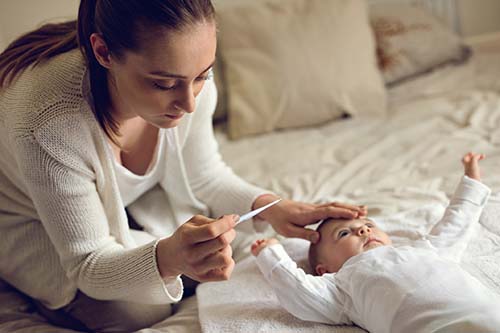Assembling a Telemedicine Appointment Kit at Home
Pediatrician Lauren Brave, MD Lists Items to Have on Hand
The landscape of medicine is changing due to the COVID-19 pandemic, and many physicians across the nation and at Boulder Medical Center are pivoting a portion of their patient care to telemedicine in order to care for patients safely and responsibly. This is a rapid and complete change from how many physicians have been trained to practice medicine, but it turns out that telemedicine is an effective approach to patient care and will likely be a viable option going forward.
At this time, however, the virtual method of patient care certainly has its limitations. Medical providers are often missing vital bits of information when they gather information over a video connection. If families can invest in a few simple tools, they can help their provider obtain more pieces of the health puzzle. I recommend that parents put together their own “Telemedicine Kit” to help optimize their virtual visit.
The following suggestions are intended to guide parents with purchases of kit items. Please note that I have no affiliation or allegiance to Walmart or Amazon; they just happen to be places where I could find inexpensive examples of the items that I am recommending. And, although this article focuses on pediatric patients, these items can be useful for adult telemedicine visits.
Checking Vital Signs
When you arrive for most visits in a clinic, you your provider will obtain what we call “vital signs”, important indicators that help tell us how your body is functioning. Vital signs include your temperature, heart rate, respiratory rate, oxygen saturation, blood pressure, and weight. You might not need all of these parameters for every single visit, but it is certainly helpful to have this information available for your telemedicine visit. If you are not sure which vital signs you should obtain, ask your physician care team prior to your visit.
Here are a few simple devices that you can use to take vital signs at home.
Thermometer
Babies under three months of age should have a rectal temperature and small children can have an axillary (armpit) temperature taken. Older children can be checked orally. There is no need to purchase a fancy thermometer.
- Here are examples of an inexpensive thermometer that can be used to take your child’s temperature.
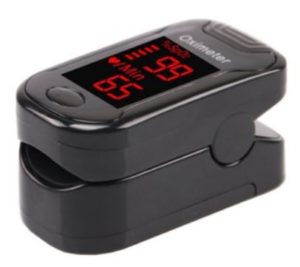
Adult finger pulse oximeter.
Finger Pulse Oximeter
A finger oximeter is probably the most useful tool to have for any visit involving respiratory symptoms and I would encourage everyone to have this device. An oximeter can check both heart rate and blood oxygen level. You can purchase devices that are specifically for small children; I recommend these for children under age 8.
- Here are examples of a regular adult device (recommended for ages 8 and older)
Respiratory Rate
No device necessary! Set the timer on your phone to 60 seconds and count your child’s breaths. This is an important piece of information, especially if respiratory symptoms are present.
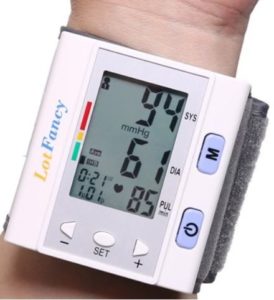
Digital blood pressure cuff
Blood Pressure Cuff
I need blood pressure data when I am doing medication checks or diagnosing head injuries. I also prefer to check blood pressure, if possible, for children over age 3. Adults certainly require this parameter with greater regularity.
- Here are examples of a blood pressure device for older children and adults.
Scale or Infant Scale
An accurate weight for children is important for medication dosing. If you have a newborn or are about to have one, an infant scale is an indispensable tool to help your doctor manage feeding and growth.
Measuring Tape
I didn’t mention height previously, but it is worth having a measuring tape handy, as there are some cases in which a height measurement is helpful.
Supporting the Physical Exam
Obtaining a physical exam is the most disrupted part of the physician/patient relationship when it comes to telemedicine visits. Touch is a sense that doctors use prominently and it’s important for patients to understand that doctor’s loss of this tool is significant.
With that said, visual exam elements are still doable. For example, looking at rashes via a video visit is still manageable although internet connection quality can impact this. I am finding that video quality is generally better on a laptop or tablet than a phone. Video clarity can be impacted by your home WiFi system, so staying close to your WIFI hub during an appointment is helpful. During the exam, I can direct patients and parents through an adequate abdominal examination. I can also look into the mouth if a child is compliant and the family has a flashlight. Looking into ears and listening to lungs have proven to be the most difficult. Here are some devices that will help with some of the physical exam elements.
Flashlight
Have a phone flashlight handy in case the mouth needs to be examined.
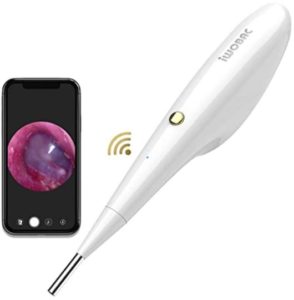
This ear wax remover is also an otoscope.
Otoscope
If your child is prone to ear infections, investing in an otoscope can be helpful. There are new and inexpensive devices that are marketed for ear wax removal and can help your medical provider see an ear drum remotely. I would recommend setting up the device and playing around with it before your visit.These devices will record on your phone and it’s probably worth making a recording of each ear drum prior to your scheduled telemedicine visit.
- Here are some otoscopes that can be purchased for home use. Technique is important when it comes to seeing the ear drum. The ear canal is curved. In order to help straighten it for an exam, hold the outer ear with your thumb and pointer finger and gently pull it up and out. This should help give a straighter view to the ear drum.
Stethoscope
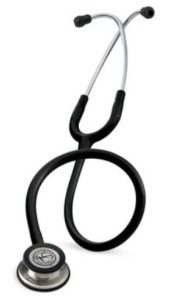 This is my biggest challenge during virtual visits. There is no digital stethoscope on the market that is affordable. I’m hopeful that as it becomes clear that telemedicine is here to stay that this device becomes an available item for purchase. For now, having the pulse oximeter is the best way to evaluate lung function..
This is my biggest challenge during virtual visits. There is no digital stethoscope on the market that is affordable. I’m hopeful that as it becomes clear that telemedicine is here to stay that this device becomes an available item for purchase. For now, having the pulse oximeter is the best way to evaluate lung function..
Here at Boulder Medical Center, we continue to evolve on a daily basis to provide care for our patients during challenging times. We feel a duty to make sure everyone stays safe from infectious disease while providing the care our patients need to live a long, healthy, and happy life. We’re on this journey together. Please continue to check in with us for updates as this situation changes.
About Lauren Brave, MD
Dr. Lauren Brave’s patients their families value her as an empathetic and attentive doctor and appreciate her honesty and directness. She enjoys watching her patients grow and thrive.
After earning a Bachelor of Science in Biology from Massachusetts Institute of Technology (MIT), Dr. Brave completed her medical training at Washington University in St. Louis and a pediatric residency at Lucile Packard Children’s Hospital at Stanford University. She is passionate about well care and preventive medicine. Dr. Brave welcomes new patients.
Resources
- Dr. Brave’s Full Profile
- Call (303) 938-4750 to make an appointment with Dr. Brave
- Meet the Pediatrics and Primary Care Team
- Learn more About Telemedicine at Boulder Medical Center

